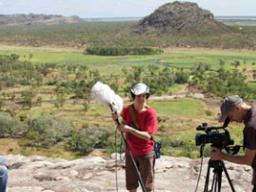Expedition to Arnhem Land in 1948
Martin Thomas (far left) during film shoot at Injalak, western Arnhem Land. Photo: Adis Hondo 2010.
Wednesday 10 August 2011
Expedition to Arnhem Land in 1948: Intercultural Inquiry in a Trans-National context
The Arnhem Land project is motivated by five key questions:- How do Western and Indigenous knowledge systems interact and inform each other?
- How do histories of intercultural research affect contemporary cultures?
- What does it mean for the discipline of history if the conventional activity of excavating and elucidating a past epoch is informed by a research practice that uses ethnographic techniques to explore the relationship between anthropological archives and the people they document?
- In what ways has Indigenous knowledge shaped Australia’s national image, its engagement with modernity and its international relationships?
- How might historical research strengthen the social fabric of Aboriginal communities?
- It resulted in the gathering of huge natural history and ethnological collections (extant in Australian and American institutions) including film, photographs and sound recordings that are of particular interest in Arnhem Land today.
- The interdisciplinary nature of the expedition, occurring at a watershed moment, makes it highly significant to intellectual, cultural and political history.
- The expedition was a collaboration between the Commonwealth of Australia, the Smithsonian Institution and the National Geographic Society. Studying it is a way of rekindling dialogue and collaboration between the original stakeholders, though now with the ambition of repatriating (rather than exporting) the intellectual property of Arnhem Land.
- The expedition, coloured by the intrigues, politics, hubris and humour that are common themes in the history of Western exploration, is a remarkable story that deserves to be told and analysed, being highly pertinent to the present moment.
Image Gallery
Martin Thomas (far left) during film shoot at Injalak, western Arnhem Land. Photo: Adis Hondo 2010.
